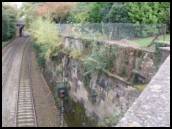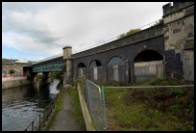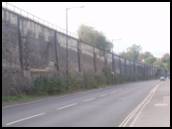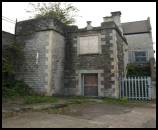Brunel's GWR
Watchdog has been in discussions with English Heritage over the inclusion of Brunel's GWR in the Tentative World Heritage List, and with Network Rail over two main subject areas, an appropriate method of protecting the railway through Sydney Gardens from trespassers, and repairs and maintenance of the railway and its environs within the Bath City boundary.
Below are separate sections, with quick links to them: World Heritage and Maintenance and Sydney Gardens and 175th Anniversary and Electrification and Bath Spa Red Wheel and Green Park Red Wheel.
World Heritage
March 2011 - the Evaluation Panel findings are published.
On 22 March, a press release announced the new tentative list of World Heritage Sites. Our bid was unsuccessful. The full text of the Evaluation Panel report was released at the same time.
Clearly the panel struggled (unsuccessfully) to provide a convincing argument why the GWR did not meet UNESCO's Cultural Criteria. "There was confusion over whether the proposal focused on the railway or Brunel" they wrote. One criterion is for a cultural asset (a railway) and another is for a work of genius (Brunel) and both are relevant; and if that genuinely confused members of the panel, then they were apparently not suitably skilled to be on the panel.
Readers are free to make up their own minds, but our interpretation of the report is that the question of whether the heritage was worth listing came a long way behind protecting the Government's policy of electrification of the line. "The opposition of the principal owner was insuperable" they wrote. Yet the UNESCO criteria do not require the owner's support; nor does World Heritage status carry much weight in the planning legislation. It was only "insuperable" because the panel (or more probably their paymasters) wanted it to be insuperable. UNESCO's desire to get more industrial heritage on their list of sites, which our bid was specifically targeted at, is thereby thwarted by petty politics.
December 2010 - the Evaluation Panel is announced.
The names of those on the panel to conduct the evaluation have just been announced. Their task is to reduce the original shortlist of 38 nominations to a much smaller list, all of which are believed to have a probability of full nomination by the UNESCO World Heritage Committee in due course.
The panel is expected to report to the Minister during January. Now that they have started work, it is too late to put in further letters of support. All we can do now is keep our fingers crossed.
September 2010 - THE "STEAM GWR 175" EVENT
 At the invitation of Swindon's Cllr Steve Wakefield, Watchdog attended the Swindon Railway Festival at the Museum of the Great Western Railway. Like Bath's Museum of Bath at Work, the Swindon museum is housed in a historic building and has a permanent display with space for special event displays.
At the invitation of Swindon's Cllr Steve Wakefield, Watchdog attended the Swindon Railway Festival at the Museum of the Great Western Railway. Like Bath's Museum of Bath at Work, the Swindon museum is housed in a historic building and has a permanent display with space for special event displays.
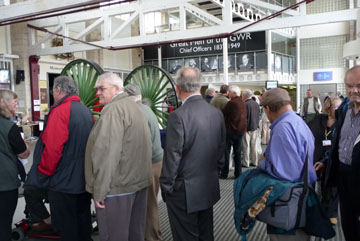 On the day we attended the special event featured model railways, with five of the fourteen model track exhibits featuring Broad Gauge working. Thus the event was attended by those who were interested in model railways, those who were interested in steam traction (including the road-going exhibits outside the main building), those who were interested in railways, and those who were interested in heavy engineering.
On the day we attended the special event featured model railways, with five of the fourteen model track exhibits featuring Broad Gauge working. Thus the event was attended by those who were interested in model railways, those who were interested in steam traction (including the road-going exhibits outside the main building), those who were interested in railways, and those who were interested in heavy engineering.
This then was our very mixed audience. And there were a lot of them: our picture shows the queues for entry tickets, and this was taken 50 minutes after the doors opened. We didn't attempt to count them, but many hundreds came through the entrance.
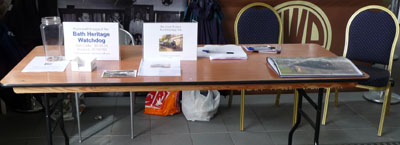 We had been provided with a table in a position where most of those attending would walk by. We had set out a few things to encourage people to stop and look, but our main aim was to talk to people.
We had been provided with a table in a position where most of those attending would walk by. We had set out a few things to encourage people to stop and look, but our main aim was to talk to people.
We discovered that very few of them knew that the previous Tentative List had been scrapped. One man was particularly disappointed because he had written an extensively researched paper of Brunel's non-railway activities along the route of the GWR which he had submitted to supplement the historical research provided by English Heritage, and that day he found out from us that his hard work had been scrapped by the previous Government.
The information on the Canterbury and Whitstable Railway was provided by the Crab and Winkle Line Trust, a charity seeking to reopen the route of the railway as a haven for walkers, cyclists and wheelchairs. We have added them to our Links page. (The reason for their name is on their website)
We learned that the Canterbury and Whitstable Railway was opened in 1830, built by George Stephenson and his son Robert, and according to the Guinness Book Of Records was the first passenger railway in the world (all before it being built to carry freight). It also included the first ever tunnel through which passenger trains ran, the half-mile tunnel through Tyler Hill. Brunel inspected this tunnel, and apparently learned the practicalities of operating trains through tunnels in terms of headroom and side clearances which would have stood him in good stead designing the GWR. He would also have noticed the problems that gradients pose: Stephenson's locomotive "Invicta", of a similar design to the more famous "Rocket", wasn't really powerful enough for the track route he had chosen.
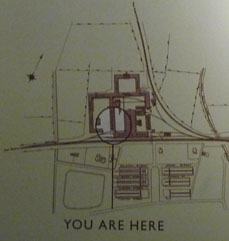 We learned that Stothert and Pitt was Brunel's favourite sub-contractor, because he could trust them to produce what he wanted on time and correctly to his drawings which he posted to them, saving the trouble of visiting to explain what he wanted. This included several steam locomotives. Nevertheless he wasn't above tempting good Stothert's workers to work directly for him with offers of high wages for responsible jobs. Most of the original works at Swindon (see the 1846 picture) were designed, built, and equipped by an ex-Stothert's employee.
We learned that Stothert and Pitt was Brunel's favourite sub-contractor, because he could trust them to produce what he wanted on time and correctly to his drawings which he posted to them, saving the trouble of visiting to explain what he wanted. This included several steam locomotives. Nevertheless he wasn't above tempting good Stothert's workers to work directly for him with offers of high wages for responsible jobs. Most of the original works at Swindon (see the 1846 picture) were designed, built, and equipped by an ex-Stothert's employee.
But our main aim was to educate on the World Heritage Site process and the bid to get the Great Western Railway onto the tentative list. Not everybody was in favour of our initiative: some worried that it might get in the way of electrification, some thought there were better candidates, some were model enthusiasts and had no interest in the full-sized GWR. But during the seven hours we were there, a couple of hundred thought that our efforts deserved success, and promised to support them. This included Swindon councillors.
Our thanks go to Swindon's Cllr Steve Wakefield for making all the arrangements to allow us to exhibit. Swindon council is wholly behind our World Heritage Site bid which would, if successful, give World Heritage status to the buildings in which the exhibition took place.
July 2010 - WORLD HERITAGE SITE NOMINATION
Following the announcement in 2009 that the Government was to draw up a new World Heritage Site Tentative List, March 2010 saw the launch of a 3-month nomination period for the new Tentative List. None of the sites remaining on the previous Tentative List qualified for automatic inclusion on the new list, so a new application would be needed for anything on the previous list that was still considered worthy of inclusion.
The Great Western
World Heritage Site
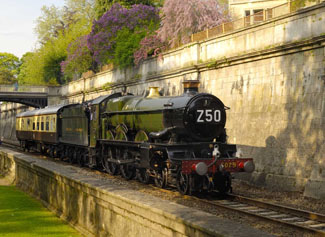
Nomination for Inscription
2010
Given the length of the GWR track, the number of Local Authorities it passes through and the number of museums and preservation societies on or near the route, it would be an impossible task in the time available to discover whether any other organisation would nominate the GWR, but we thought the risk that nobody would was too great to ignore. So Watchdog entered into discussions with organisations familiar with the nomination process (see our report further down in this section dated March 2010) with the aim of producing an up-to-date submission for Brunel's Great Western Railway. In the absence of any of these volunteering to take the lead, Watchdog decided to produce and submit the nomination documentation. The box on the right shows what we used as a cover illustration.
Nomination Summary
The nomination submitted was largely derived from the English Heritage report 'The Great Western World Heritage Site: The genesis of modern transport 2006'. This report was the basis of the nomination on the previous list and clearly made a very strong case for the inscription. English Heritage are advisors to the Government on the significance of heritage assets and their importance, so their report is a valid today as it was then. Some quotes from that report are:
'The Great Western Railway is regarded as the most complete early main line railway in the world. That it was one of the major achievements of the great engineer Isambard Kingdom Brunel is an important consideration'.
'The proposed Great Western World Heritage Site is truly a remarkable monument to virtuosity in 19th century transport engineering in Britain and to Isambard Kingdom Brunel's genius, and, as such, it is of outstanding universal significance'.
Further evidence came from the report 'Railways as World Heritage Sites' by Andrew Coulls for UNESCO, and again we offer a quote:
'Above all the GWR is as an excellent demonstration of how the criterion of works illustrative of genius may be applied in many ways. The railway was dominated more than any other in Britain, by the vision of just one man, Isambard Kingdom Brunel'.
Watchdog's own knowledge of the heritage assets in Bath attributed to Brunel was also useful, adding new information to the previously published material, to produce a fully rounded argument in favour of Inscription.
In June the nomination was submitted to and accepted by DCMS, and on 7 July after the initial sift the full list of nominations was announced. The full list can be found on the DCMS Website, and ours was one of 38 accepted to go through to the next stage.
Support Needed
Watchdog's submission was sufficiently well argued and presented to survive the initial sift. In order to ensure the greatest chance of the Great Western Railway reaching the new Tentative List, we originally asked for expressions of public support, but the opportunity for that is now past.
March 2010
In pursuit of our aim to have better care taken of the railway assets through Bath, Watchdog has been liasing with the World Heritage section of English Heritage, with Network Rail, and has been interviewed by Steam Railway magazine. This section reports our progress to date.
Brunel's Great Western Railway

'By his death the greatest of England's engineers was lost, the man with the greatest originality of thought and power of execution, bold in his plans, but right. The commercial world thought him extravagant; but although he was so, great things are not done by those who sit down and count the cost of every thought and act'
Sir Daniel Gooch
Isambard Kingdom Brunel takes his place in the remarkable pantheon of great British engineers that dominated the structural, mechanical and transport revolutions for a century. His achievements and vision captured the imagination of his contemporaries and subsequent generations and in 2003 Brunel was voted, by the public, to be the second Greatest Briton in history. His leading role in the transport revolution of the Victorian era, on land and sea, left an indelible mark on the British landscape. Constantly questioning received wisdom, his colossal energy, bravery and determination to carry out projects on the largest scale to an extremely high standard and set him apart from his rivals. Brunel was outstandingly a man of his times - the epitome of the heroic Victorian engineer and a true creative genius.
Great Western Railway World Heritage Site Nomination
In 1999 the United Kingdom produced a Tentative List of World Heritage Site nominations in response to the UNESCO World Heritage Committee's signal that more sites representing global industrialisation should be considered for inscription. Eleven of the nominations on the list were industrial. That most relevant to Bath was the inclusion of Brunel's Great Western Railway.
The Great Western Railway between London and Bristol was authorised by Parliament in 1835 and the detail of its construction was entirely the conception of Isambard Kingdom Brunel. Construction started in 1836 and the railway opened in stages from 1838 and throughout its length in 1841 with the completion of Box Tunnel, arguably the greatest engineering feat of early railway construction. Built to Brunel's broad gauge of seven foot and a quarter inch its engineering works achieved a grandeur unmatched elsewhere in the country. As their general proportions were suited to high speed running most of these structures have survived in daily use with the section from Didcot westwards to Bristol running largely on unaltered formations.
Proposed Great Western Railway Site
The site proposed for nomination is a complex linear one that can be thought of as a 'string of pearls' loosely linked by the line of the railway containing further 'beads' which provide a context but are not formally part of the site itself. The 'pearls' are the 8 nominated elements and the 'beads' include, amongst others, the Great Western Railway Centre at Didcot and the ornamental viaduct and massive embankment through Chippenham.
The proposed site comprises eight outstanding individual elements. It is restricted to features on the line of the Great Western Railway from London to Bristol and to the Great Western Dock, with the SS Great Britain in Bristol. All eight elements are directly associated with Isambard Kingdom Brunel, arguably Britain's most innovative engineer. It does not include present day track and operational infrastructure.
The sixth 'pearl' is the section of railway through the City of Bath from its approaches to Sydney Gardens in the east to the tunnels at Twerton in the West.
This section is one of the most impressive and varied sections of urban railway landscape in the world. At its eastern end the railway enters Sydney Gardens and Brunel provides a fittingly theatrical setting for his railway. The railway is seen as one of the attractions of the gardens, lined by a balustraded promenade and crossed by sweeping masonry bridges and graceful cast iron bridges, before plunging under Bathwick Hill in a tunnel. The classical St James Bridge over the Avon is approached by a 32 arch viaduct across Dolemeads and leads directly to Bath Station. At Bath Station the architecture abruptly changes. The station itself is Brunel 'Jacobethan', while the turreted and bridge and viaduct to the west of the station is medieval and the viaducts and bridges to Twerton are Jacobean. The construction of the viaduct at Twerton required the demolition of mill workers housing, Brunel therefore inserted cottages into some of the arches in compensation. These are probably the only example of Brunel domestic architecture in the country. This section of the proposed Site ends with the castellated portals of the two tunnels beyond Twerton.
English Heritage Position
In October 2008 Bath Heritage Watchdog contacted Dr Christopher Young, Head of World Heritage and International Policy at English Heritage, regarding the progression of the nomination of Brunel's Great Western Railway between London Paddington and Bristol as a World Heritage Site. We were disappointed with the reply:
GREAT WESTERN RAILWAY: PADDINGTON - BRISTOL (SELECTED PARTS) TENTATIVE LIST
Thank you for your letter of 12 October enquiring about progress on the proposed nomination of selected parts of the Great Western Railway as a World Heritage Site, as set out in the United Kingdom Tentative List in 1999. That Tentative List contained 25 proposals. Of these, nine are now inscribed on the World Heritage List.
The government announces from time to time which sites from the Tentative List it intends to nominate to the UNESCO World Heritage Committee as World Heritage Sites. The selection of sites for actual nomination has depended on a number of factors such as the commitment of the key stakeholders, including owners and users of each site, the condition of the site, likely achievability of inscription on the World Heritage List in the light of changing priorities of the UNESCO World Heritage Committee, and the state of the necessary documentation for each site.
The current commitment is to nominate Pontcysyllte Aqueduct and its Canal (submitted January 2008 for decision by the World Heritage Committee in 2009), re-nominate Darwin at Down (January 2009 for Committee decision in 2010), and to nominate Monkwearmouth and Jarrow Monastic Site (January 2010 for decision in 2011). The government will not make any future commitments to nominate sites until it has completed a review of its World Heritage policy.
The Government is looking to publish a consultation document on its UK World Heritage Review shortly. Should the Government decide to revise the current UK Tentative List following consultation, appropriate guidelines on applications for inclusion on a new List will be made available. Subject to the results of the consultation, it is probable that any site on the current Tentative List will have to be proposed afresh by the appropriate group of stakeholders as there will not be an automatic right of inclusion for these sites on any proposed new Tentative List.
There are therefore no current plans to take forward the nomination of the Great Western Railway. I hope that this clarifies the current position on the Great Western Railway for you.
I am copying this letter to colleagues at DCMS and within English Heritage for information
Yours sincerely
Christopher Young
Dr Christopher Young
Head of World Heritage and International Policy
CC Peter Marsden DCMS Chris Smith EH Andrew Vines EH Sue Cole EH
There are only three railways inscribed as World Heritage Sites: the Mountain Railways of India (1999, 2005 & 2008), the Semmering Railway, Austria (1998) and the Rhaetian Railway in the Albula, Italy/Switzerland (2008). The Great Western Railway pre-dates all three but is unique in that is includes associated assets along the route.
Out of 17 World Heritage Sites in England only 4 are industrial. Out of 25 World Heritage Sites in the UK only 6 are industrial. We consider this to be woeful and in our opinion demonstrates an absolute lack of commitment to our vitally important industrial and social history.
The advent of the steam railway, and in particular the inter-city railway, pioneered in Britain was perhaps the most influential of the astounding changes that took place during the Industrial Revolution. Of the early main line railways, the Great Western was one of the most innovative, reflecting the genius of Isambard Kingdom Brunel. It is today also one of the most complete. The GWR was in Brunel's own words 'the finest work in England' and many of its structures bear testimony to Brunel's innovative thinking. Brunel concerned himself with every level of design and detail combining the talents of a surveyor, a civil engineer, a mechanical engineer, an architect and planner - and his legacy displays this wide-ranging creativity.
We do not believe that this nomination should simply be allowed to fade away and become
forgotten. To this end we have been writing to interested parties requesting that they too write to DCMS and English Heritage to insist that the Great Western Railway is not only retained on the UK list of nominated sites but also put forward as soon as possible for inscription. For those who wish to support our campaign please write to:
| Peter Marsden DCMS 2-4 Cockspur Street London SW1Y 5DH |
Dr Christopher Young English Heritage 1 Waterhouse Square 138-142 Holborn London EC1N 2ST |
Letters to newspapers and magazines can also elicit support.
An article run in the January edition of Steam Railway magazine is reproduced on a separate page. We thank all of those at Steam Railway magazine for their support in this campaign and for their kind permission to reproduce the article on our website.
Go back to top index
Repairs and Maintenance
Great Western Railway Brunel Assets in Bath
Whilst working on the above campaign, members of Bath Heritage Watchdog carried out a survey of the many Brunel railway assets in Bath.
Sydney Gardens Embankment & Bridges - Grade II*
Bath Spa Station & Station Ramps - Grade II*
St James' Railway Bridge - Grade II
Skew Bridge - Grade II
Railway Bridge & Arches, Lower Bristol Road - Grade II
Twerton Viaduct, Station House & Arches 1-13 - Grade II
Entrances to Twerton Wood Tunnel - Grade II
Entrances to Twerton Tunnel - Grade II
We were appalled to see the current state of repair many of them were in, though it must be emphasised that there is no current risk to the safety of the railway operations.
Concerns included the amount of established Buddleia (particularly destructive to stonework), crumbling stonework and the poor state of the Twerton Station House which is included on the BANES Buildings at Risk List.
|
|
|
|
We sent our concerns directly to the Chief Executive of Network Rail, copying in the BANES Heritage & Environment Department. After an exchange of correspondence, on 15 January two Watchdog members met with four representatives of Network Rail, a representative from the Railway Heritage Trust and a BANES Senior Conservation Officer.
The four hour meeting consisted of a series of site visits to Bath Spa Station and the adjacent Viaduct, the Twerton Station House and Viaduct, and Sydney Gardens. At each site concerns were discussed with possible solutions and actions required debated. The subject of enhancement work such as a lighting scheme at the station viaduct was also discussed but it was agreed that the priority was to improve the condition of the listed assets.
A promise to remove the Buddleia urgently was made and agreed, together with any minor stonework repairs. A regular maintenance programme to continue this on a rolling basis was requested to prevent further damage to stonework. This we will monitor on an ongoing basis.
Matters such as stone cleaning and major repairs require a conservation plan and programme which Network Rail have committed to. The Railway Heritage Trust has also pledged to provide input and, subject to a suitable conservation plan, grants to aid work. Collaboration with the Senior Conservation Officer was also agreed in order that such important work is carried out in the correct way.
Discussions were also held with a view to renovating the derelict arches adjacent to Bath Spa Station with a view to their use for small businesses.
It is fully understood that Network Rail has a limited amount of funding for such work. However, as was pointed out at the meeting, delays to repairs of such important listed assets leads to higher expenditure in the long term. Network Rail and the Railway Heritage Trust have pledged to keep in contact with Watchdog with a view to progressing matters in due course. They have also promised consultation on a forthcoming fencing initiative. We shall, of course, ensure that this promise is kept.
[22/3/09] Following Watchdog's meeting with Network Rail, the Railway Heritage Trust and a BANES Senior Conservation Officer in January 2009, communication has continued on a regular basis with all parties involved concerning the condition of the Brunel assets in Bath.
[29/3/09] Watchdog has been keeping an eye on progress, and work has now started to the environs of the Twerton Station House and Bridge as Network Rail promised.
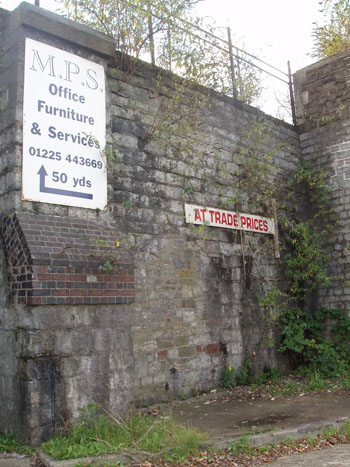 The redundant signs on the viaduct in front of the Station House (pictured left) have been removed as has a great deal of the vegetation. The picture below (with apologies for the parked car that was in the way on the day we turned up with a camera) shows how thoroughly the work was done.
The redundant signs on the viaduct in front of the Station House (pictured left) have been removed as has a great deal of the vegetation. The picture below (with apologies for the parked car that was in the way on the day we turned up with a camera) shows how thoroughly the work was done.
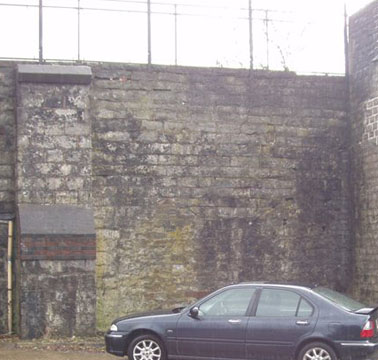
The walls on the Twerton side of the bridge have also had vegetation removed from the stonework. Compare the January (left) and March (right) photographs below.
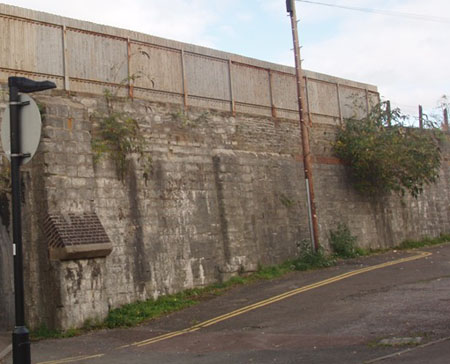
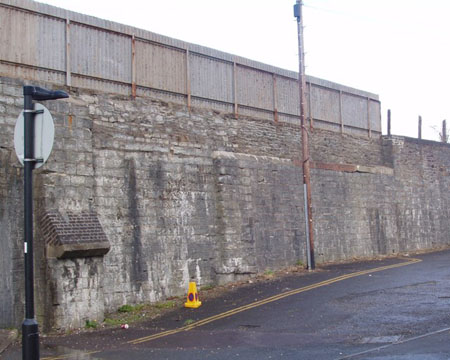
The biggest improvement has been the removal of overgrown vegetation, rubbish such as mattresses and general detritus from the corner of land to the rear of the Station House section of the viaduct. These two close-ups (below) taken in January show just how overgrown this area had become, even before the perennial weeds start to grow in the spring.
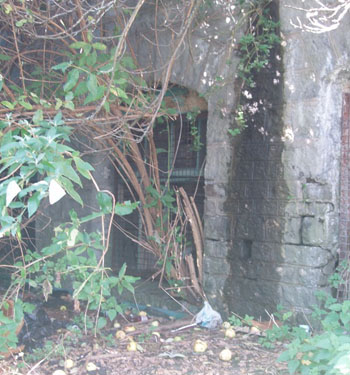
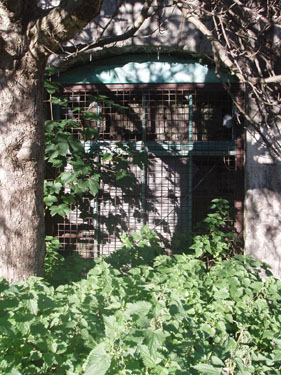
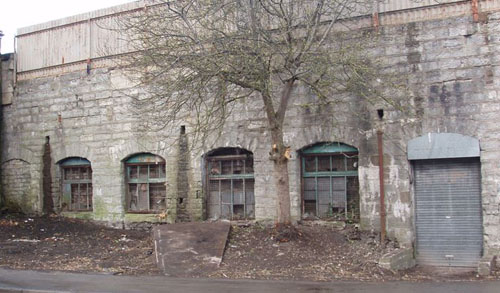 Compare the wide angle picture taken in March. The before and after pictures show the immense difference that this makes to the Brunel listed assets. Eventually, Network Rail want to turn the cleared area behind the station into a public garden.
Compare the wide angle picture taken in March. The before and after pictures show the immense difference that this makes to the Brunel listed assets. Eventually, Network Rail want to turn the cleared area behind the station into a public garden.
Clearly there is much more work to be done and the clearing of some of the vegetation has revealed more damaged stonework which will need to be addressed.
In addition it is likely that the vegetation will need to be treated with weedkiller in order to stop regrowth. However, Watchdog is pleased that Network Rail has started a programme of conservation and will provide further updates in due course.
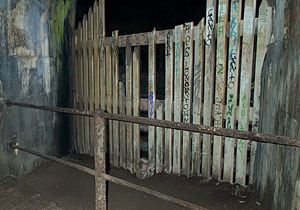 [5/4/09] Watchdog has been keeping an eye on progress, and has spotted the latest repairs.
[5/4/09] Watchdog has been keeping an eye on progress, and has spotted the latest repairs.
Brunel built a stone bridge over the railway to carry the axis path through Sydney Gardens, whilst under that path he built a tunnel to carry the trackside path.
Below the bridge in that tunnel are two fenced arches beside the tracks, and when we photographed them in February they were both in a sorry state, see pictures right and below left.
Those fences have been restored, as shown in the picture below right.
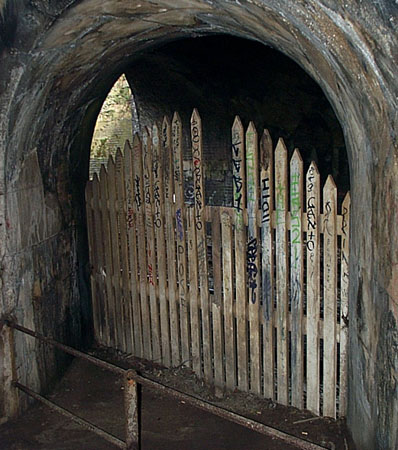
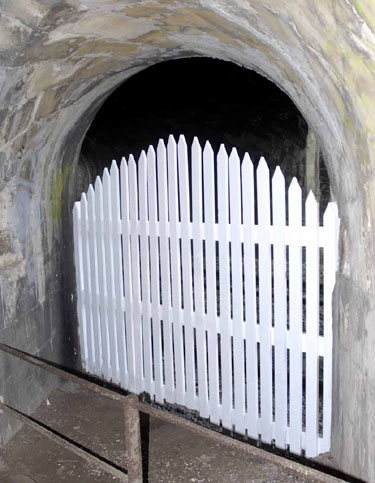
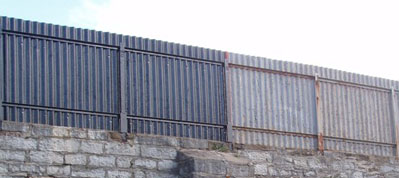
![]() [19/4/09] Further work has taken place, and Watchdog is delighted to show the results here.
[19/4/09] Further work has taken place, and Watchdog is delighted to show the results here.
The first of the new work is around Twerton Station where the fencing has been repaired and repainted. The picture on the right shows the work in progress with the fencing in its original condition on the right and the painting part finished on the left.
At the back of Twerton Station, similar results are seen.
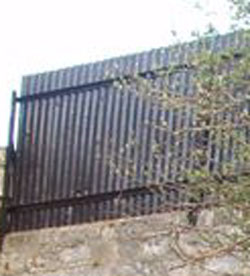 The picture on the left was taken in January, and the picture on the right was of the same piece of fence, taken at Easter.
The picture on the left was taken in January, and the picture on the right was of the same piece of fence, taken at Easter.
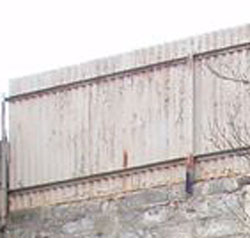
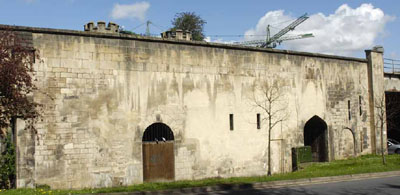 The other piece of completed work spotted recently was the cleaning and repairing of the stonework on the south side of the arches as they cross the Churchill Bridge roundabout.
The other piece of completed work spotted recently was the cleaning and repairing of the stonework on the south side of the arches as they cross the Churchill Bridge roundabout.
Unfortunately, we had not taken a picture of this stonework in its original state to show as a comparison, but from memory there was a lot of weed root damage to the stonework visible from the bottom of Wells Road, and this has all been restored.
Twerton Station
The area of most immediate concern was the Twerton Station House which remains on the B&NES register of Buildings at Risk. We understand that Network Rail has had funding approved to appoint an architect and engineer to assess the condition of the building and to produce a program of works designed to bring the building back to a usable condition, and one commensurate with its importance. Initial meetings in this regard were due in late March but unfortunately have had to be cancelled.
Regrettably squatters broke into the station building. We understand that they were removed and arrested by Transport Police and that the building was again secured. Unfortunately we have since been informed that they have again gained entry and that the police now consider this to be a civil matter between the squatters and Network Rail. Network Rail is currently seeking legal advice to secure eviction.
Sadly this means that funding due to be spent on bringing the building back from the brink is now being spent on legal fees. Until the situation is resolved no further survey or design work can be carried out.
Watchdog hopes that this can be brought to a swift and satisfactory conclusion, without further damage being incurred by this important Brunel building.
Twerton Arches
We understand that the tenants of the arches have been reminded that the arches are now listed (English Heritage listed both the station and the arches on 21 July 2008), and that they should tidy their forecourts and respect the buildings.
Network Rail has also undertaken to remove redundant signage, paint the existing metal parapet and remove the vegetation. The small parcel of land behind the Station House is to be cleared.
Although there is a long way to go, Watchdog is grateful to Network Rail for making these initial steps and continue to support and communicate with them in this respect.
Twerton Station Restoration
The Twerton Station House is one of Brunel’s railway structures in Bath with which there is great concern: so much so that it appears on the Council’s ‘At Risk’ Register. As part of our ongoing work concerning Brunel and the GWR in Bath, we have lobbied for the restoration of this very important building and for a new appropriate use to be found.
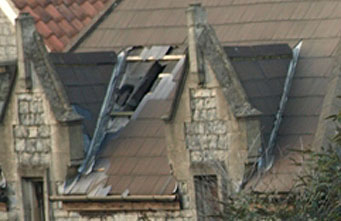 After the squatters were finally evicted, the building was secured against further re-entry but left in a derelict condition. Of particular concern was the holes in the roof which would allow the rain to get in and cause progressive deterioration to the inside.
After the squatters were finally evicted, the building was secured against further re-entry but left in a derelict condition. Of particular concern was the holes in the roof which would allow the rain to get in and cause progressive deterioration to the inside.
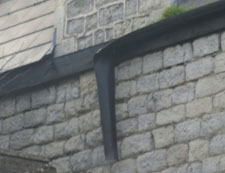 Much of the guttering was also in a sorry state (picture left), and that would be contributing to the damp penetrating into the building. In October 2010 Network Rail submitted a Listed Building Application 10/04239/LBA for the reroofing of the building. This included the reinstatement of a natural slate roof, releading of the central flat roof and cast iron guttering and rainwater goods.
Much of the guttering was also in a sorry state (picture left), and that would be contributing to the damp penetrating into the building. In October 2010 Network Rail submitted a Listed Building Application 10/04239/LBA for the reroofing of the building. This included the reinstatement of a natural slate roof, releading of the central flat roof and cast iron guttering and rainwater goods.
In February 2011 the building was shrouded in protective screens over scaffolding as work got underway. When the scaffolding was removed, most of the roof was repaired, but not that part facing the track. We contacted Network Rail in April 2011 to express our concerns that work had stopped and that contractors had left the site.
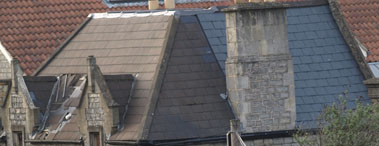 We were informed that the interior was secure and weathertight but that the remaining work could not be completed until possession of the line was possible, most likely in 2016 because repairs to a roof were not sufficient justification alone to require a closure of the rail services.
We were informed that the interior was secure and weathertight but that the remaining work could not be completed until possession of the line was possible, most likely in 2016 because repairs to a roof were not sufficient justification alone to require a closure of the rail services.
The picture on the left shows the hole covered with plastic sheeting, and the slightly lighter colour of the new slates until they weather shows the other work that was completed.
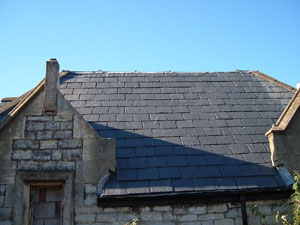 In June 2011 Network Rail informed us that they had been able to complete the work and provided some photos from the trackside which they have kindly given us permission to reproduce on this website. In addition we were informed that the internal timbers were in better condition than expected and replacement was therefore at a minimum. The new rainwater drainage and repointing using lime mortar will also help defend the building against damp. Full marks to Network Rail, that they kept the requirement in mind, and one day in June while track maintenance was taking place, the roofers finished off the job. The picture on the right was taken the day afterwards.
In June 2011 Network Rail informed us that they had been able to complete the work and provided some photos from the trackside which they have kindly given us permission to reproduce on this website. In addition we were informed that the internal timbers were in better condition than expected and replacement was therefore at a minimum. The new rainwater drainage and repointing using lime mortar will also help defend the building against damp. Full marks to Network Rail, that they kept the requirement in mind, and one day in June while track maintenance was taking place, the roofers finished off the job. The picture on the right was taken the day afterwards.
The building work in the planning application is now complete.
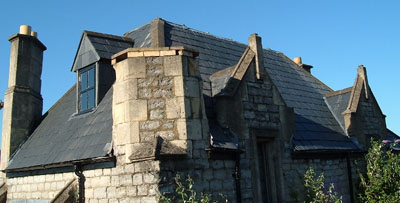
The project has clearly enhanced the appearance of this significant listed building and more importantly has preserved it from further deterioration thus securing its immediate future. There is clearly much more work that needs to be done to make it usable again and this we will continue to lobby for. We thank Network Rail for the work that has been carried out, and for the photographs of it.
The inside still needs a lot of restoration, but Network Rail are not inclined to do the work until someone wants to use the building and is prepared to pay rent for it when restored. In times of restricted budgets such caution can't be criticised. Most of the damage that needs to be rectified was done while the building was unused, and running the risk of that happening again after spending a lot of money restoring the interior is difficult to justify financially, no matter how much we would like to see the restoration completed.
Go back to top index
Sydney Gardens
Background
The historical context of the gardens is an important factor in understanding their purpose and importance at the time they were created, and their relevance and value in the present day.
The Sydney Gardens were created as commercial pleasure gardens between 1792 and 1794, opening on 11 May 1795. They were known as the 'Sydney Gardens Vauxhall', their underlying purpose to create a pleasant open space within Bath for the purposes of entertainment. At that time admission was by subscription or purchase of tokens and it was the place for fashionable people in Georgian Bath to meet and be seen, be entertained and to take refreshments. A stone wall enclosed the whole of the gardens.
The Kennett & Avon Canal was cut across the gardens in 1800. Although clearly an intrusion into the gardens, the insertion of the canal was carried out in a sensitive manner, with it running at a lower level than the gardens in order not to detract from views. John Rennie's design included two decorative cast-iron Coalbrookdale bridges which spanned the canal and two stone bridges with suitable ornament. In addition the alignment was planned to avoid special features in the gardens such as the labyrinth and castle ruins. Rennie positioned one of his bridges to restore the route of the axis path which would otherwise have been broken by the canal. It can be argued that the canal added to the picturesque scheme of the gardens.
n 1839 work began on the section of the Great Western Railway that runs through Sydney Gardens. While the design of the canal endeavoured to avoid any important features, the railway cut straight across, sweeping away the labyrinth, castle and walkways and destroying the remainder of the outer ride. The cutting through Sydney Gardens resulted in exceptional architecture because Brunel concerned himself with every level of design and detail combining the talents of a surveyor, a civil engineer, a mechanical engineer, an architect and planner, creating railway structures which were designed to blend in with the picturesque designs of the garden. The railway added new features within the landscape of Sydney Gardens resulting from the construction of two retaining walls, a footbridge to connect the footpath from the Holburne Museum to Sydney House, a cast iron footbridge and two road bridges which form part of the boundary to Sydney Gardens.
Brunel being a typical showman, utilised the gardens to create a fittingly theatrical setting for his railway. It could have been hidden in a cutting or a tunnel, but Brunel wanted his railway to be seen by all, so it was designed to be accessible to visitors to the gardens. The railway and its associated structures soon became an attraction in their own right and groups of spectators gathered to watch the passing trains.
Bath City Council purchased the gardens in 1908 and resold a portion to the Holburne Trustees. This remains separated from the rest of Sydney Gardens as it is today. The remainder became a public park.
Sydney Gardens were included on English Heritage's Register of Parks and Gardens of Special Historic Interest at Grade II on 25 June 1992. The main building is the Holburne Museum (Grade I), with many other individually listed buildings within the park's boundaries.
The retaining walls and bridges to the section of the Great Western Railway at Sydney Gardens are designated at Grade II* for the following principal reasons:
• They are designed by Isambard Kingdom Brunel and form part of the internationally important Great Western Railway
• They are purposefully and sensitively designed in a classical style to blend in with the other garden structures in Sydney Gardens and form important landscape features in their own right
• They are early examples of railway structures which survive substantially intact.
Bath & North East Somerset Council is currently working on a Conservation Plan for Sydney Gardens as part of the necessary works for a bid for Heritage Lottery Funding. Therefore, any scheme for securing the boundary of the railway has to be considered in this context.
It is also important to recognise that this section of the railway is much used by parents letting their young children view the trains, and by photographers and railway enthusiasts catching sight of "Specials" (particularly those that are steam hauled), and these modern access requirements should be preserved.
Network Rail's Position
For approximately 250m only a small balustrade wall separates Sydney Gardens from the operational railway where trains can run up to 40 miles per hour. As the railway is accessible, it is open to trespass and/or vandalism. Since 2005 there have been:
• 95 serious incidents of trespass, of which 29% involved children or youths
• 6 incidents of objects being placed on the line
Network Rail are under a firm obligation to prevent access to the railway to meet modern Health and Safety requirements, but recognise that the listed environs impose constraints. To clarify the public's reaction to some possible options, a public exhibition with a questionnaire was mounted in Bath Library on 17th, 18th and 19th February 2009, with the expectation that the public's views would be submitted by 9 March.
Network Rail's Exhibited Proposals
The public consultation offered three possible solutions. The following information is summarised from the Network Rail information boards
Option 1: Railings attached to the wall:
Advantages:
• Height increased making it more difficult to access the line
• Visitors would still be able to get an extremely close view of passing trains
Disadvantages:
• Condition of the wall would make this option extremely challenging
• Work would be required to Brunel's original wall
• Requires listed building consent
Option 2: Park-side fencing
Advantages:
• No alterations to Brunel's wall
• Easy to engineer and quick to complete
• Fencing would be ornamental and in keeping with the character of the park
Disadvantages:
• Wall would be obscured by the fence (which could be further back to avoid listed building consent)
• May require listed building consent or land owners consent
Option 3: Enhanced ha-ha scheme
Advantages:
• A ditch is used to maintain an uninterrupted view
• A fence on its inner side below ground level prevents access
• Fence can be obscured by planting a hedgerow
Disadvantages:
• Visitors to the park would not get as close to the wall as currently
• Is likely to require consents, the minimum being landowners consent
Bath Heritage Watchdog's Verdict
Bath Heritage Watchdog fully appreciates the position of Network Rail and the constraints involved in finding an appropriate way to address the serious safety concerns, balancing the character of Sydney Gardens, protecting Brunel's railway assets and considering residents' views.
After careful consideration and several site visits to Sydney Gardens, Bath Heritage Watchdog considered that none of the options offered at the public exhibition afforded sufficient protection of the historic assets or access to the views of the railway. The reasoning is given below:-
Option 1: Railings attached to the wall:
• Causes undue intervention into the Grade II* balustrade
• Causes considerable visual harm
• Children or vandals pulling on the railings would cause irreparable damage to the balustrade
Option 2: Park-side fencing
• Balustrade would be obscured by the railings causing visual harm
• Children or vandals pushing on the railings would cause irreparable damage to the balustrade due to its close proximity to the stonework
• Potential damage to the foundations of the balustrade when installed
Option 3: Enhanced ha-ha scheme
• This is a ditch (It is not a ha-ha, which would provide a sheer drop and be too dangerous for this location)
• Visitors would be a considerable distance from the railway
• Views of Brunel's balustrade would be obscured
• Further views would be obscured if the hedge were allowed to grow too tall
• Imposes a maintenance overhead on the Parks Department to keep it trimmed
• Two of the sections would not be wide enough to take such a ditch
• An inappropriate intervention into the historic park
However, it is not sufficient to simply state that Watchdog did not like any of the proposals exhibited. If none were considered suitable, then further alternatives should be offered.
Watchdog's Ideas for Sydney Gardens
We started with the assumption that there were two types of access needed: the keen photographers wishing to photograph particular trains (mostly "Steam Specials"); and the casual visitors, with or without cameras who just wanted to watch the railway in operation.
Rather than arrive at a single scheme for controlling public access to the railway while still allowing the railway to be viewed, Bath Heritage Watchdog has examined the areas at risk in three sections, and has offered at least one solution to each section.
To keep the number of permutations down to an acceptable number, the area needing to be protected from public trespass has been subdivided into:
• Section A – from Sydney Road bridge to the Iron Bridge
• Section B – between the Iron Bridge and the Stone Bridge
• Section C – between the Stone Bridge and Beckford Road bridge
The intention is to outline possibilities, some of which are more aesthetically pleasing than others, but all of which should be sufficiently effective in preventing trespass to satisfy Network Rail. These have focused on physical barriers in the vicinity of the past trespass offences. The intention is to provide the basis for negotiation between Network Rail, the council’s Heritage and Historic Environment staff and the council’s Parks Department, allowing a chosen compromise to be eventually agreed and implemented.
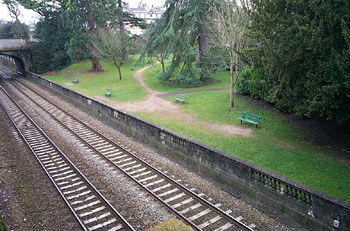 Essentially, Watchdog has suggested gating access to Sections B and C, with those gates only unlocked on the days that the keen photographers need trackside access. The general public would be offered easy access to Section A only (that area pictures on the right). Within that approach, a number of options are identified.
Essentially, Watchdog has suggested gating access to Sections B and C, with those gates only unlocked on the days that the keen photographers need trackside access. The general public would be offered easy access to Section A only (that area pictures on the right). Within that approach, a number of options are identified.
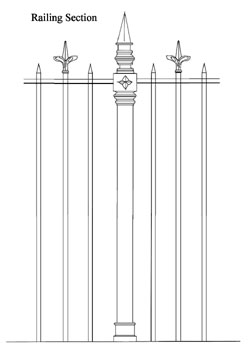 Watchdog proposed a choice between two types of access to this area - either a fence set back from the railway with a gate that is normally open during the day allowing the public easy access to the trackside during daylight but with the gate locked at night when the worst of the trespass incidents occur; or a similar bank to that used above the other sections, topped by a fence, giving access to a viewing platform, so that the public can easily see the railway, but would be physically prevented from reaching it.
Watchdog proposed a choice between two types of access to this area - either a fence set back from the railway with a gate that is normally open during the day allowing the public easy access to the trackside during daylight but with the gate locked at night when the worst of the trespass incidents occur; or a similar bank to that used above the other sections, topped by a fence, giving access to a viewing platform, so that the public can easily see the railway, but would be physically prevented from reaching it.
The style of fence shown here is sketched from Brunel's own design for fencing at Bath Spa Station, so we would expect it to look authentic.
Copies of a document providing these ideas in a lot more detail than the summary above have been sent to Network Rail, the council's Heritage Environment team and the Parks Department, and Watchdog will take part in any further discussion if invited. We are waiting to hear what those who have copies of the document think of the ideas put forward. We will update this section once we have received that feedback.
In order to get permission to actually construct something, Network Rail will have to raise planning applications, and when that happens, we will bring them to public attention.
A Straw Poll
Saturday 28th March 2009 was to see the return of GWR Castle Class 4-6-0 no 5043 Earl of Mount Edgcumbe to the classic ‘Bristolian’ run for the first time in 45 years. Members of Watchdog decided to view its return from Sydney Gardens but we also arranged for one member to be at Oldfield Park Station.
Unfortunately the steam special wasn’t to be. An hour before it was due, news filtered through of the engine’s failure at Oxford. It was to be towed to Didcot where it was to be examined and hopefully repaired, but it would not be passing through Bath that day. The disappointment within the crowd that had assembled was palpable. Although a large number were dedicated steam enthusiasts, families and other interested onlookers had also gathered.
Watchdog members spent some time talking to those who had turned up. Some were local and had seen the exhibition and had provided their own feedback. But we were surprised to learn that news of the proposals to segregate the railway had already reached far and wide. Indeed two enthusiasts who had travelled all the way from Derby to see this engine in Sydney Gardens, had heard of the proposals and voiced their concern and opposition for such a move. It is clear that Brunel’s design for Sydney Gardens to be the place to view his trains is as popular today as it was then.
The consensus of the people spoken to was that if there had to be a barrier, it should be one well away from the balustrade wall, that allowed free access in the daytime and could be locked at night. Indeed, all those who spoke to Watchdog made it clear that they were opposed to any proposals that kept enthusiasts from the trackside, and all would be watching developments with great interest.
Go back to top index
A Sad Anniversary
By his death the greatest of England's engineers was lost ...
15th September 2009 marks the 150th anniversary of the death of the great Victorian engineering genius Isambard Kingdom Brunel.
Embodying the energy and ambition of the period, he had a huge capacity for innovation in design, and was at the forefront of the group of engineers who enabled the Industrial Revolution. Brunel fought for progress and forward thinking in engineering and, although his designs are universally revered today, during his own lifetime they were often subject to controversy.
In his relatively short lifetime, he designed ships, docks, tunnels, bridges, the Great Western Railway and other rail lines, and even a flat-pack hospital that was shipped to the Crimea. Notably, the GWR route was the only rail line in the country that could accommodate the Inter-City 125 trains running at full speed when they were introduced, because Brunel had designed the line for fast trains to use.
Despite his achievements, Brunel often faced disappointment and his untimely death could be partly attributed to the stress of taking on such colossal commitments. He is an example of the advantages and perils of brilliantly determined people taking full responsibility for every phase of their projects.
Regrettably we are not aware of any local events commemorating the 150th anniversary of his passing.
Yet in Bath, we have some rare assets:
• Bath Spa Station is still very much as he designed it, though it has lost the canopy over the tracks and the platforms have been extended slightly. Unfortunately, the council considers Brunel's carriage ramp as disposable, and would rather see an open space that does not comply with the Disability Discrimination Act instead.
• The cutting through Sydney Gardens (see above) which was designed to be a tourist attraction. Unfortunately, Network Rail want to see it fenced off and inaccessible to tourists.
• In the Twerton area are the cottages built into the railway arches. This is the only time Brunel ever turned his hand to residential designs. Yet look at the pictures and see how badly Bath looks after this unique legacy.
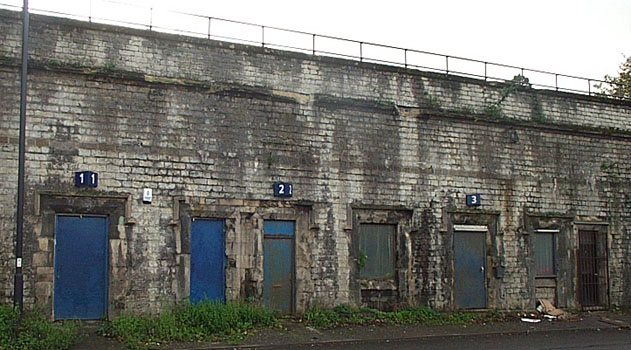
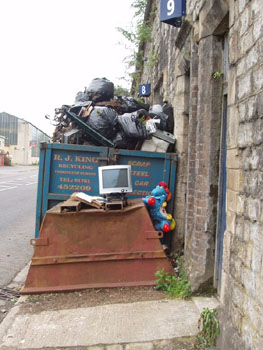
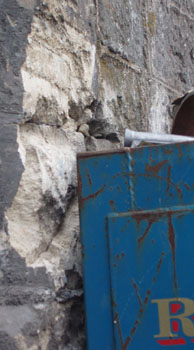
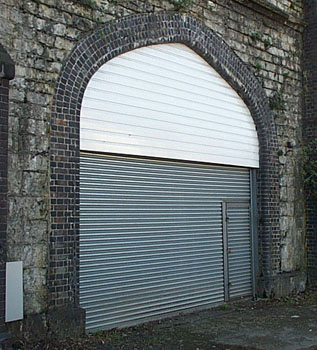
Go back to top index
A Happier Anniversary.
31 August 2010 marks the 175th anniversary of the granting of the Royal Assent of the Great Western Railway Bill in Parliament. We hope that this extremely important date will not be allowed to pass unnoticed and will be pressing for commemorations to be held.
Regular readers of this site will be aware that Bath Heritage Watchdog has been working with various agencies including Network Rail and the Railway Heritage Trust regarding the Brunel Assets in Bath. This work is continuing and we hope to bring further news of progress in due course. But we can announce our first achievement.
Brunel Assets Newly Listed
As part of our ongoing work regarding the Brunel assets in Bath, we identified two bridges in the Oldfield Park and Twerton areas of the city, Brook Road Bridge and Bellotts Road Bridge, which we believed formed part of the original Brunel GWR construction and which were not listed.
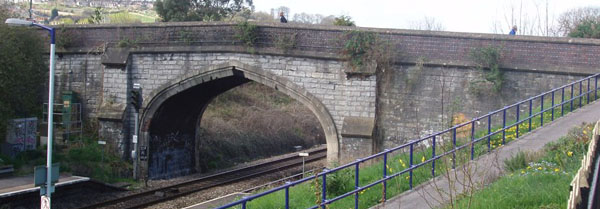 For those not familiar with the area, Brook Road Bridge (pictured right) looks over Oldfield Park Station.
For those not familiar with the area, Brook Road Bridge (pictured right) looks over Oldfield Park Station.
Since that photo was taken, Watchdog has persuaded Network Rail to remove the buddleia, but the repairs to the stonework where the roots have caused damage are still outstanding.
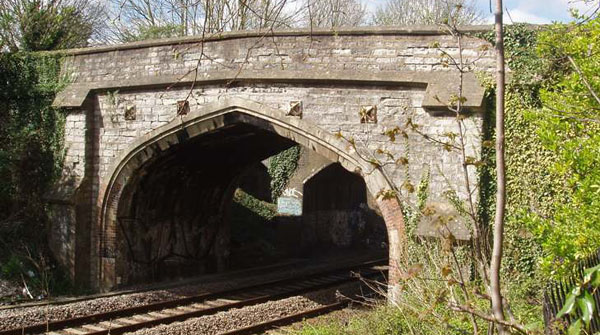 Bellotts Road Bridge (picture right) is more difficult to see (this photograph was taken from Twerton Cemetery, and a Somerset & Dorset railway bridge masks the other side), but again it shows invasive plants. Some buddleia is visible, but mostly it is ivy that gives cause for concern. We shall raise this with Network Rail.
Bellotts Road Bridge (picture right) is more difficult to see (this photograph was taken from Twerton Cemetery, and a Somerset & Dorset railway bridge masks the other side), but again it shows invasive plants. Some buddleia is visible, but mostly it is ivy that gives cause for concern. We shall raise this with Network Rail.
A Watchdog member carried out detailed research on both structures and having found evidence that these bridges were original Brunel structures, applied to English Heritage for their listing.
This week English Heritage confirmed the good news that both bridges had been listed at Grade II. The full listing texts are available on the English Heritage Listed Buildings On-line website (Bellotts Road is entry 507645; Brook Road is entry 507647) but the reasons for designation are set out below. The same reasons are given for each bridge:
Built in 1839 for the GWR, the structure is listed at Grade II for the following principal reasons:
Architectural: Tudor-gothic design which is characteristic of work on the Bristol-Bath Division of the GWR.
Historic: The GWR was one of the earliest established railway companies in England and thus the bridge is an early example (1839) of a railways structure dating from the pioneering phase in national railway development.
Association: The bridge is constructed to a design by the engineer and architect Isambard Kingdom Brunel, widely perceived as one of the most important transport engineers of the C19.
Intactness: It survives relatively intact, despite some patching to the arch.
Group Value: Strong group value with other listed structures on the GWR especially nearby Twerton Viaduct and Brook Road Bridge/Bellotts Road Bridge. This group value is enhanced by the structures’ shared architectural style.
As this year is the 175th anniversary of the Royal Assent for the Great Western Railway Bill we are delighted at these listings, a fitting tribute to the genius of Isambard Kingdom Brunel.
Go back to top index
Bellotts Road Bridge.
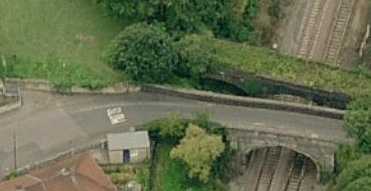 Despite Bellotts Road Bridge being Grade II listed (see the item immediately above), on Saturday 18th January 2014 we were alerted to work taking place beside the listed bridge which had deliberately damaged it. No listed building consent had been applied for. The picture on the right shows a view of the bridge before this work took place.
Despite Bellotts Road Bridge being Grade II listed (see the item immediately above), on Saturday 18th January 2014 we were alerted to work taking place beside the listed bridge which had deliberately damaged it. No listed building consent had been applied for. The picture on the right shows a view of the bridge before this work took place.
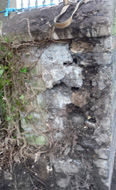 We discovered that the wall which continues left from the bridge parapet in the picture on the right had had a part demolished. A closer inspection of the broken end of the bridge (pictured left) confirmed that the missing wall had been part of the parapet with engineering brick either side, and therefore is Grade II listed with the bridge.
We discovered that the wall which continues left from the bridge parapet in the picture on the right had had a part demolished. A closer inspection of the broken end of the bridge (pictured left) confirmed that the missing wall had been part of the parapet with engineering brick either side, and therefore is Grade II listed with the bridge.
In the absence of listed building consent before the work started, a criminal offence (under Section 7 of the Planning (Listed Buildings and Conservation Areas) Act) has been committed. It looks as though a gap has been knocked through to allow contractor's plant to get through, despite the fact that access could have been achieved via Burnham Road without affecting any listed structure.
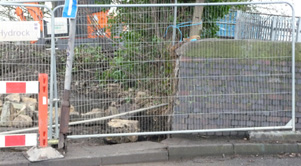 In conjunction with Network Rail's Engineering Group, arrangements will need to be made to restore the wall quickly. In its original state it was designed to ensure that rain was deflected away from the bridge, but now that it has an exposed end with an irregular surface, rain will penetrate and remain inside the structure, and it is only a matter of time before frosts freeze the rain that penetrated, bringing the risk that bricks from it might be prized out and fall onto the railway. Getting the listed wall restored as original might need the legal force of an Enforcement Notice.
In conjunction with Network Rail's Engineering Group, arrangements will need to be made to restore the wall quickly. In its original state it was designed to ensure that rain was deflected away from the bridge, but now that it has an exposed end with an irregular surface, rain will penetrate and remain inside the structure, and it is only a matter of time before frosts freeze the rain that penetrated, bringing the risk that bricks from it might be prized out and fall onto the railway. Getting the listed wall restored as original might need the legal force of an Enforcement Notice.
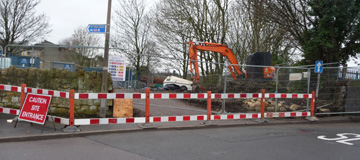 Once these necessities are completed, there needs to be an enquiry into who proposed the demolition, in order to set up safeguards to prevent similar actions being taken in the future.
Once these necessities are completed, there needs to be an enquiry into who proposed the demolition, in order to set up safeguards to prevent similar actions being taken in the future.
Go back to top index
Skew Bridge Arches.
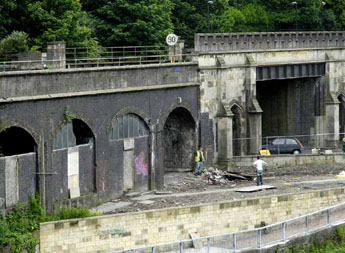 Watchdog's involvement started in May 2009, when Property Services attempted to improve the view of the Skew Bridge arches as seen from the brand new bus station. Our first news of this was when we saw demolition workers taking down the north walls (pictured right). When we checked, we discovered that these walls were not part of, nor attached to the listed structure, and we had to admit that in their dilapidated state, they were no loss. Even the temporary timber screens that replaced them were an improvement.
Watchdog's involvement started in May 2009, when Property Services attempted to improve the view of the Skew Bridge arches as seen from the brand new bus station. Our first news of this was when we saw demolition workers taking down the north walls (pictured right). When we checked, we discovered that these walls were not part of, nor attached to the listed structure, and we had to admit that in their dilapidated state, they were no loss. Even the temporary timber screens that replaced them were an improvement.
But when we looked into the arches as the walls came down we were concerned at the internal condition and asked to discuss our unease with Property Services, who responded positively by inviting us to have a closer look and discuss options.
So after the timber screens were in place, we went along for a detailed look.
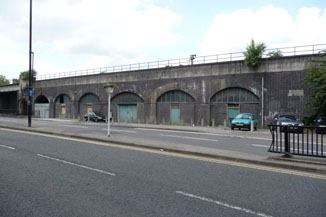 We met up on the Widcombe side, where similar temporary walls blocked off the arches. These arches belong to Network Rail, and are leased to the Council. In the past, they had been let to businesses, but over time the condition of them had deteriorated, and they were now considered unusable. When we saw inside, we could see why.
We met up on the Widcombe side, where similar temporary walls blocked off the arches. These arches belong to Network Rail, and are leased to the Council. In the past, they had been let to businesses, but over time the condition of them had deteriorated, and they were now considered unusable. When we saw inside, we could see why.
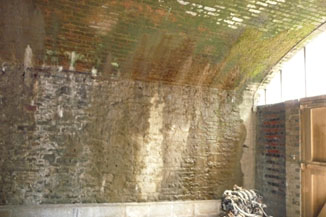 In the picture on the right, the walls were running with damp, and where the daylight entered, moss and algae were well established. Rubbish from the previous business use still sat on the wet floor.
In the picture on the right, the walls were running with damp, and where the daylight entered, moss and algae were well established. Rubbish from the previous business use still sat on the wet floor.
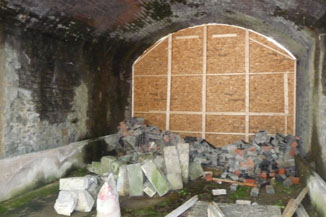 In another arch, the newly installed temporary wall made a backdrop to rubbish standing in a shallow lake, while water and black mould graced the walls (picture left). It smelt unpleasant. The assessment that the arches were unfit to be let was well founded.
In another arch, the newly installed temporary wall made a backdrop to rubbish standing in a shallow lake, while water and black mould graced the walls (picture left). It smelt unpleasant. The assessment that the arches were unfit to be let was well founded.
Our researches suggested that when first built, these arches were open, though were were not able to find a picture of this exact spot to prove it. Property Services and ourselves agreed that if they were again opened up, the appearance would be considerably improved, and the ventilation would allow them to dry out, which would benefit the structures. The underlying problem was money: the council's budget would only stretch to bollards in the entrances to stop the arches being used as impromptu parking spaces, and we thought that bollards would not prevent them being used as campsites for rough sleepers, or as convenient places to trade and use banned substances. Nor would Brunel have contemplated bollards in his arches: they would look out of place. If Brunel had wanted to put anything across the arches, it would have been railings.
Back at the Watchdog meetings, we discussed the problem. As 2010 is the 175th Anniversary of the Royal Assent for the Great Western Railway Bill, and we knew that despite all the Brunel heritage in Bath very little was taking place to commemorate it, we thought that restoring these arches would be a good, permanent reminder of the anniversary. We approached Network Rail, (who have a website covering their heritage activities) who met us and said that they thought it an excellent idea, but pointed out that they had a limited maintenance budget. They suggested that we contacted the Railway Heritage Trust who might agree to a grant. They agreed in principle that such a development could qualify for a grant, but wanted to see firm designs and accurate costings before they gave a definite answer, and they would not fund the whole scheme.
There followed a few weeks of what can best be described as shuttle diplomacy. Watchdog offered alternative designs for railings within the listed arches, which Property Services checked with the Heritage Environment Team to eliminate any that would be refused Listed Building Consent, then had the short list priced. Designs and prices were then negotiated with the interested parties with Watchdog acting as the common point of contact, until eventually it was agreed that the cost would be split roughly evenly between council, Network Rail and the Railway Heritage Trust, based on an adaptation of Brunel's design for railings at Bath Spa Station on the Widcombe side and a simpler "Victorian" style on the unlisted northern side, chosen to complement the newly renovated railings on the riverside path refurbished as part of the Southgate project, to minimise the overall cost. Property Services would project manage the planning permissions, contracts and installation, which all went to plan.
The installation work is now completed and paid for, and we are delighted with the outcome. All that is left is a solution to the weeds on the northern side, of which more later. Meanwhile, the completion of the installation was signalled by a photo opportunity and a report in the Chronicle. Watchdog had agreed to give the project no publicity until that stage was reached, but is now free to tell the whole story.
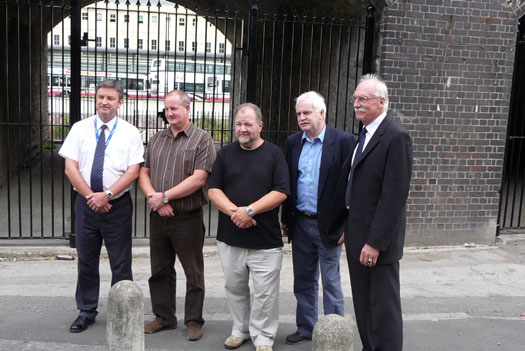 The picture on the left shows the main characters who attended the photo opportunity. The Railway Heritage Trust was invited, but could not attend on the dates offered. Network Rail intended to be there, but after everything was arranged sent their regrets.
The picture on the left shows the main characters who attended the photo opportunity. The Railway Heritage Trust was invited, but could not attend on the dates offered. Network Rail intended to be there, but after everything was arranged sent their regrets.
So from left to right are Jeff Sprawson (our main contact in Property Services), Nigel Davis (of TPM Southwest Ltd, a local Bath company that did the masonry work for this project), Patrick Hutton (Watchdog Chairman), Cllr Malcolm Hanney (B&NES Cabinet Member for Resources), David Chung (of Weldcraft Engineering Ltd, a Timsbury company that made and installed these railings - and according to their website, the Royal Crescent railings).
The two pictures below show the railings on the south (Widcombe) side on the left, and the railings on the north (river path) side on the right.
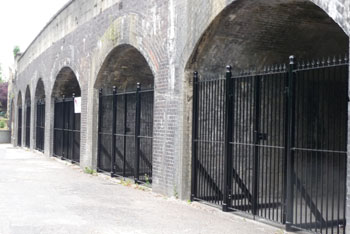
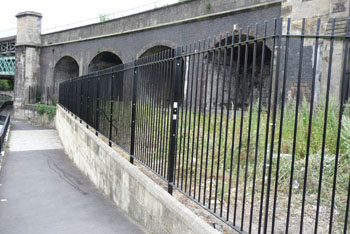
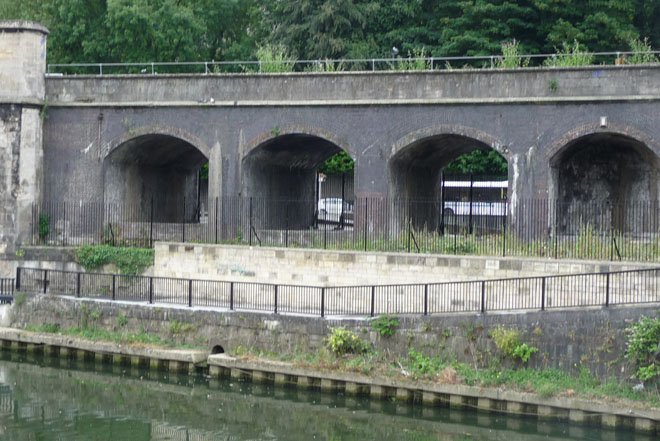 Our final picture shows the vastly improved view that is seen through a bus window as it enters the bus station. We believe it is a fitting tribute to the genius of Isambard Kingdom Brunel in the 175th Anniversary year.
Our final picture shows the vastly improved view that is seen through a bus window as it enters the bus station. We believe it is a fitting tribute to the genius of Isambard Kingdom Brunel in the 175th Anniversary year.
Watchdog extends its thanks to all those who believed in this project, and by their hard work made it happen. A look at the inside of the arches during the photo shoot showed that they are drying out nicely already.
There are a few remaining loose ends. We will be liaising with Network Rail to get the weeds growing from the stonework and along the trackside above the arches removed. We will keep in touch with Property Services in the hope that the old and discoloured concrete bollards on the Widcombe side might eventually be replaced with painted steel ones to complement the new railings.
The Parks Department are currently treating the weeds between the arches and the riverside path with weedkiller to finish off the project, but they don't want to be responsible indefinitely for this piece of land as a garden. Some of the weeds are pernicious and will require several treatments over many weeks before they stop coming back. Once the area is totally cleared, and we can see what sort of terrain is under all the current foliage, we will begin discussions with the appropriate departments to see what the possibilities for this area are. There is room for improvement, but whatever is done must be affordable and practical in the long term.
Go back to top index
Skew Bridge Walkway.
Brunel's original Skew Bridge (below left) was part timber part iron when it was originally built in 1840, and constructed more than adequately to carry the weight of the trains of its time. As time went on, more powerful and heavier trains used the line, and eventually for reassurance, in 1878 a steel bridge supported on Brunel's original bridge pillars replaced the timber and iron original. This bridge was strengthened again in the 1960s and listed in 2000.
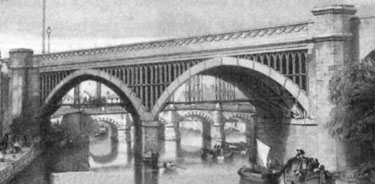
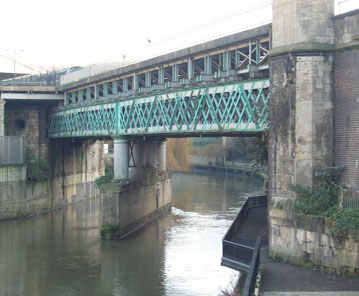
(Note that the original is pictured looking west and the later one is looking east.)
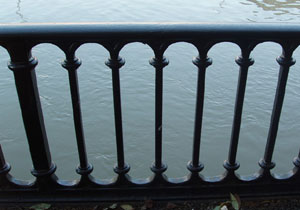 The railings beneath the Skew Railway Bridge (to the west of Bath Spa Station) were restored in 2009 (pictured right) as part of the Southgate development. They were not listed in themselves but considered as curtilage listed with the Skew Bridge.
The railings beneath the Skew Railway Bridge (to the west of Bath Spa Station) were restored in 2009 (pictured right) as part of the Southgate development. They were not listed in themselves but considered as curtilage listed with the Skew Bridge.
Having spotted a resemblance to the railings on the Brunel cast iron footbridge over the railway in Sydney Gardens a Watchdog member carried out detailed research on both the railings and the associated cantilevered walkway, clearly seen on the right of the modern picture and just visible under the left arch of the original bridge.
Having found apparent pictorial evidence that both dated from the time of the original Brunel GWR construction (the western abutment of the bridge interrupted the towpath, so a cantilevered walkway was constructed at the same time to give a path around it) an application was made to English Heritage in March 2010 for listing. Given the association with the Skew Bridge it was decided to apply for an amendment to that listing entry rather than request a new separate new entry.
This week (24 January 2011) English Heritage confirmed the good news that the cantilevered walkway and the railings had both been added to the Skew Bridge Grade II listing. The following entry has been added to the listing text:-
'SUBSIDIARY FEATURES: Beneath the western arch of the bridge, the towpath of the Avon Navigation is carried on a cantilevered iron walkway with semi-circular cast-iron railings running for a distance of 31.5m. The walkway dates from the original construction of the bridge in 1840 whereas the railings are believed to have been installed to coincide with the opening of the replacement wrought-iron bridge in 1878'.
 An engraving of the bridge by James Holloway, published around 1840, and a lithograph by J C Bourne, published in 1846, clearly shows the existence of the cantilevered walkway but they are not sufficiently detailed to compare with the railings that exist today. Although it has not been possible to prove that the railings date to the original GWR construction, the cantilevered walkway is, and is not only of special interest as an original component of the Brunel bridge, but it also illustrates the juxtaposition of the two modes of transportation that played a significant role in the industrial prosperity of Bath in the 19th century.
An engraving of the bridge by James Holloway, published around 1840, and a lithograph by J C Bourne, published in 1846, clearly shows the existence of the cantilevered walkway but they are not sufficiently detailed to compare with the railings that exist today. Although it has not been possible to prove that the railings date to the original GWR construction, the cantilevered walkway is, and is not only of special interest as an original component of the Brunel bridge, but it also illustrates the juxtaposition of the two modes of transportation that played a significant role in the industrial prosperity of Bath in the 19th century.
Go back to top index
Electrification.
Watchdog was invited to meet Network Rail on 4 October 2012 to meet area representatives, including a member of the team responsible for electrifying the Bath segment, to discuss the associated issues. The aim was to explore the main issues rather than discuss solutions at this stage.
We were informed of the Government's vision on electrification, which is to not only electrify the inter-city services (which is what has received all the publicity so far) but also ultimately to electrify the local services and the freight services too. There was a desire to align the readiness of the track to take electric services with the end-of-life replacement of rolling stock so that the need for dual fuel locomotives (powered by either electricity or diesel) was kept to the absolute minimum, because these units are very expensive. Due to this long term vision, any gaps in the electrified network would be problematical, and Network Rail have been told that just electrifying the Swindon to Bristol Parkway route and leaving Swindon to Bristol Temple Meads via Bath unaltered was unacceptable.
We were informed that "Third Rail" solutions would not be possible in Bath because of the locations with springs or drainage problems which would risk the reliability of the service, particularly in winter. Also rolling stock for third rail systems are designed for a different type of power supply, and the overhead line supplies could not be adapted to also operate a third rail service, so Bath would need a dedicated tap from the high voltage National Grid running to a new major sub-station and different locomotives. None of these variations would be sanctioned.
Network Rail are very aware of the sensitivity of Bath, which is why they are engaging with what they referred to as local stakeholders much earlier than their normal practice. They are also dispensing with the functional teams that were responsible for the East Coast Line (one group handling track works, one the gantries and power wires etc) and have formed a combined team responsible for the Bath loop to ensure all the issues were coordinated. We met one of the Bath project team managers at meeting, and found him well briefed on the issues to be tackled.
We were able to dispel some rumours: there were no insurmountable issues at Paddington Station; there were no listed structures within Bath that would prevent electrification and therefore be under threat of demolition, though some may need "in keeping" modifications to ensure the appropriate safety distances between high voltage electricity and the public; there was no requirement (or intention) to remove the S&D bridge at Bellotts Road which the "Two Tunnels" project hoped to use; there was no need to install unsightly major sub-stations within Bath to power the railway; there would (hopefully) be no need to close any sections of line during normal railway operating times; none of the intermediate stations (eg Oldfield Park) was under threat.
We were informed that the process of electrification would also embrace restoration works to the structures through Bath, and that a far more aesthetic solution to Sydney Gardens than the current temporary fence (installed on the insistence of the Office of the Rail Regulator) would be part of that. Nevertheless, routine maintenance would not lapse in the interim.
The "in keeping" modifications were where the local consultations would be important, because locally there would be an understanding of style, form, materials and character which Network Rail would not have. Local architects had been engaged to advise, particularly on the design and positioning of the supporting structures for the overhead wires, and local consultations would be part of that process. Obviously there are engineering considerations that the architects must address, but local consultations can inform the aesthetic considerations.
The meeting was very useful in that it set out the inevitabilities: Bath will have electrified services, and these services will be using the same overhead power line system that the rest of the Western Region will use. With that inevitability comes the promise of what could be some major restoration works to the existing structures, and a dedicated Network Rail project team that understands the sensitivity of Bath and wants to find a solution to the inevitable that Bath can live with, if not actually love.
Watchdog was offered further consultation meetings at appropriate points in the planning, which we gratefully accepted.
Meanwhile, we will put our thinking caps on. If Brunel was told in 1840 that he had to accommodate electric power and modern safety standards in his designs, what might he have designed for Bath? . . .
Electrification Deferred
In the interval between writing the above and the headline in the Chronicle that electrification through Bath has been deferred, Watchdog had attended almost all of the public drop-ins, had taken part in all the Stakeholder Meetings to put our input into the design discussions, and had educated three different Network Rail Section Managers on the problems posed by the geography of Bath by walking the line with them pointing out all the issues along the route that had to be taken into account when preparing the implementation plans. A lot of these were listed structures, but we also identified important views into and across the World Heritage Site and dwellings where the only outdoor space was inside the clearance radius from the overhead electrical equipment (OLE) and dwellings built on top of tunnels where opening windows above the line gave access to the OLE beneath them.
In fairness to Network Rail, they took all these away and subsequently arrived at mitigation measures, and track lowering, track realignment and shielding hoods provided a "least damage" compromise between heritage and safety regulations. However these measures added additional costs to the "price per kilometre" assumption provided by the Department for Transport. It is no surprise that the outlay then needed to be re-profiled by adjusting the timescale.
The April 2017 work to Bath Spa Station will nevertheless have to go ahead. The DfT still want to introduce the new, longer trains to the original timetable and that requires the lengthening of a platform at Bath Spa to cater for the additional length. That work to lengthen the platform also requires the increase in width of the existing platforms to re-align the curve to ensure that the gap between platform and carriage is kept to a minimum. A Grade II* Listed building constructed with the rails high above the road level is not an easy thing to amend for new rolling stock, but because the rolling stock is already made the station alterations are essential, even if the line is never electrified.
Go back to top index
Red Wheel.
The Transport Trust is a charity established to promote and encourage the preservation and restoration of Britain's unique transport heritage in all its forms. In 2009 it launched its Red Wheel scheme, a nationwide programme to mark sites of historical interest with Red Wheel plaques. The Red Wheel scheme has been likened to the English Heritage Blue Plaque scheme, but whilst Blue Plaques mark buildings with associations with famous people, Red Wheels commemorate Britain’s globally important legacy in the development of transport.
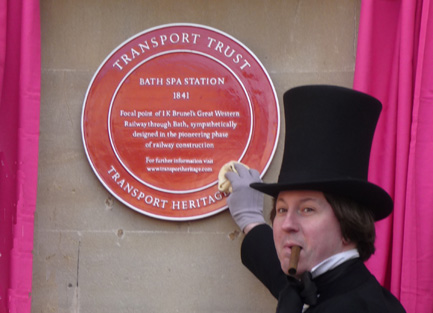 Watchdog took the view that if there was sufficient evidence of the importance of Brunel's Great Western Railway to get onto the tentative short-list of candidates for a World Heritage Site nomination (see "World Heritage" above), then the special efforts Brunel took to make his railway fit for the special character of Bath (almost all of which has been listed) should make it suitable for Red Wheel recognition. Thus began a long and mutually beneficial relationship between the Transport Trust and Watchdog, with Watchdog being guided through the process of justification, agreeing location and wording for the Red Wheel for Bath, and in return advising the Trust through the administration needed to attach a Red Wheel to a nearby listed building they had chosen to recognise, Claverton Pumping Station.
Watchdog took the view that if there was sufficient evidence of the importance of Brunel's Great Western Railway to get onto the tentative short-list of candidates for a World Heritage Site nomination (see "World Heritage" above), then the special efforts Brunel took to make his railway fit for the special character of Bath (almost all of which has been listed) should make it suitable for Red Wheel recognition. Thus began a long and mutually beneficial relationship between the Transport Trust and Watchdog, with Watchdog being guided through the process of justification, agreeing location and wording for the Red Wheel for Bath, and in return advising the Trust through the administration needed to attach a Red Wheel to a nearby listed building they had chosen to recognise, Claverton Pumping Station.
As far as the Bath Red Wheel was concerned, there were a few possible locations that featured Brunel's genius, but we ultimately concluded that the Red Wheel should be the doorway to all the Brunel structures in Bath rather than a recognition of just one of them. The advantage of the Red Wheel Scheme is the much wider interpretation of industrial sites achieved through the associated Transport Trust website which is under development. In this case, although the plaque is installed on the front elevation of Bath Spa Station, the website will refer visitors to the wider structures associated with the Great Western Railway and Brunel in Bath, from Sydney Gardens through to the Twerton Tunnels. It is hoped this wider interpretation will inspire people to explore the other sites and to appreciate what is one of the finest and largest collections of Brunel structures in one city.
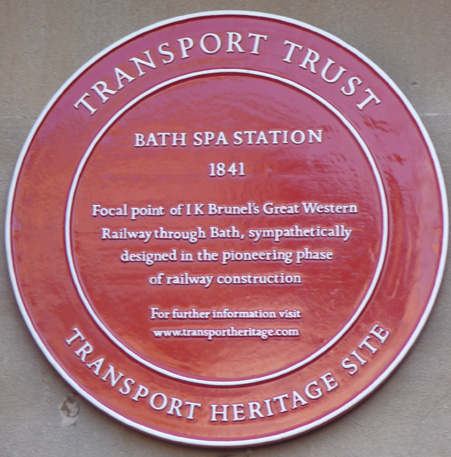 Guided by the advice that the Red Wheel should be placed where the maximum number of people should see it, it was decided that a position on the front of Bath Spa Station would be best, except that the front of the station was at that time an untidy clutter of (mostly unauthorised) advertisements and signage and the opportunities were limited by them.
Guided by the advice that the Red Wheel should be placed where the maximum number of people should see it, it was decided that a position on the front of Bath Spa Station would be best, except that the front of the station was at that time an untidy clutter of (mostly unauthorised) advertisements and signage and the opportunities were limited by them.
We suggested that the Trust should seek pre-application advice on the best position of the possible options, and we were invited to the ensuing site visit to discuss the preferred location. This gave the opportunity to discuss the presence of the unauthorised advertising with the Station Management, which ultimately led to its removal. The way was then clear to raise the necessary listed building application, and Watchdog and the Trust worked together to decide on the exact wording to go on the Red Wheel. Watchdog also provided the photographs and the Heritage Statement for the Listed Building Application, and the Trust provided all the technical details of the plaque and its fixings. In November 2012, the application was given consent.
Network Rail agreed to remove all the weeds growing from the stonework which would mar the views of the Red Wheel, and to arrange as part of their routine maintenance for the removal of similar weeds along the length of line through Bath so that those who did explore the other Brunel structures would see them at their best. First Great Western not only agreed to have the plaque mounted on the station, they arranged for it to be fitted, and worked with Watchdog to prepare for the unveiling ceremony.
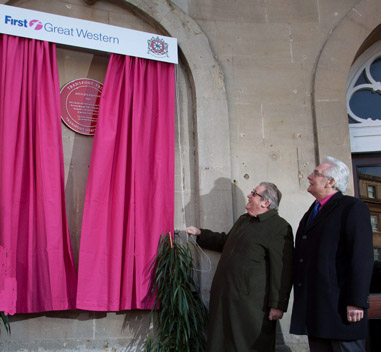 The Transport Trust regarded the Bath plaque as important, so much so that they arranged for their President, The Hon Sir William McAlpine Bt to do the unveiling, which took place on 18 February 2013. In his speech Sir William said that this was the 47th Red Wheel to be installed and a special occasion because a plaque had been requested by Bath rather than the Trust choosing what to commemorate. He was also amused to see that Isambard Kingdom Brunel was there to watch the unveiling!
The Transport Trust regarded the Bath plaque as important, so much so that they arranged for their President, The Hon Sir William McAlpine Bt to do the unveiling, which took place on 18 February 2013. In his speech Sir William said that this was the 47th Red Wheel to be installed and a special occasion because a plaque had been requested by Bath rather than the Trust choosing what to commemorate. He was also amused to see that Isambard Kingdom Brunel was there to watch the unveiling!
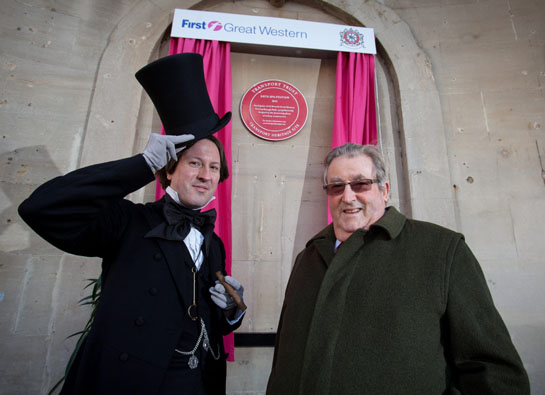
This was very much a team effort, and Watchdog is grateful to the willing co-operation of all the parties involved. Without the assistance of the Transport Trust, First Great Western, Network Rail, the pre-application case officer, the B&NES Member Champion for Historic Environment and Heritage, Box Brewery who supplied "Brunel", and Cafe Au Lait who so admirably looked after the refreshments for the VIP guests afterwards, the Red Wheel Plaque we instigated to draw attention to the Great Western Railway and the works of Brunel's genius in the city would not have gone as smoothly as it did.
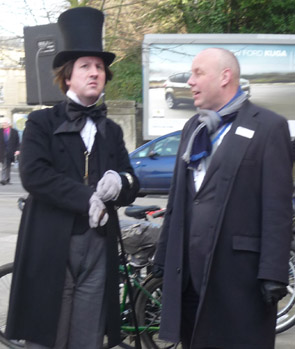
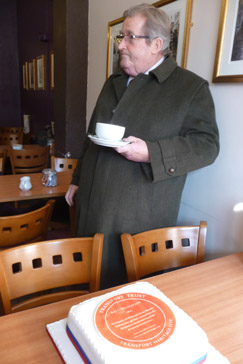
To complete our photo montage we have:
Left: First Great Western Station Manager Peter Rignall greets Isambard Kingdom Brunel.
Right: Sir William McAlpine, chairman of the Transport Trust with the commemorative cake made for the occasion in the foreground.
Go back to top index
Green Park Station's Red Wheel.
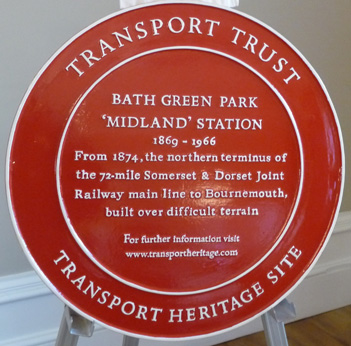 Bath's other terminus station, Green Park Station was similarly honoured by the Transport Trust with its own Red Wheel on 29 April 2016. This was commemorated with a different type of ceremony in a location less dependent on the weather and the installation programme. In the interval (and after more than thirty other plaques awarded) since the Bath Spa ceremony, the Transport Trust had adopted an approach of presenting and unveiling the Red Wheel plaque on a temporary mounting, leaving the final installation afterwards on the location commemorated to local arrangements.
Bath's other terminus station, Green Park Station was similarly honoured by the Transport Trust with its own Red Wheel on 29 April 2016. This was commemorated with a different type of ceremony in a location less dependent on the weather and the installation programme. In the interval (and after more than thirty other plaques awarded) since the Bath Spa ceremony, the Transport Trust had adopted an approach of presenting and unveiling the Red Wheel plaque on a temporary mounting, leaving the final installation afterwards on the location commemorated to local arrangements.
Watchdog had no active part in the Green Park Red Wheel preparations which had been led by Cllr Neil Butters who had secured Listed Building Consent for the installation of the Red Wheel onto the fabric of the station building. Cllr Butters also invited us to the unveiling ceremony, for which we are grateful. It gave us the chance to view the Red Wheel at close quarters (see picture) before its installation.
The unveiling was preceded by speeches, by Peter Stone of the Transport Trust to explain the work of the Trust towards the protection, the conservation, the restoration and the promotion of Britain's transport heritage, with the most important of these heritage sites being identified by a Red Wheel awards. He also described the progress made so far in identifying those transport structures that merit such an award.
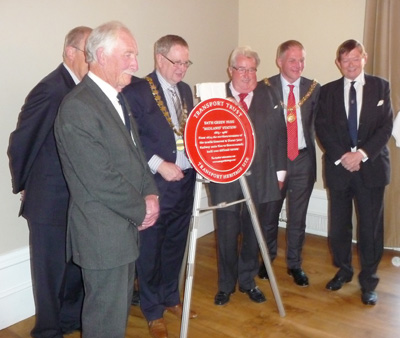 Cllr Butters then assembled the group he had been working with, ready for the
photograph to be taken to mark the occasion (which gave Watchdog the opportunity to take similar photos, used here) and described in a short speech the success of his Listed Building planning application, which permitted the installation in the station foyer, and his preference, shared by the Transport Trust, for an alternative location on the outside of the building and thus more visible.
Cllr Butters then assembled the group he had been working with, ready for the
photograph to be taken to mark the occasion (which gave Watchdog the opportunity to take similar photos, used here) and described in a short speech the success of his Listed Building planning application, which permitted the installation in the station foyer, and his preference, shared by the Transport Trust, for an alternative location on the outside of the building and thus more visible.
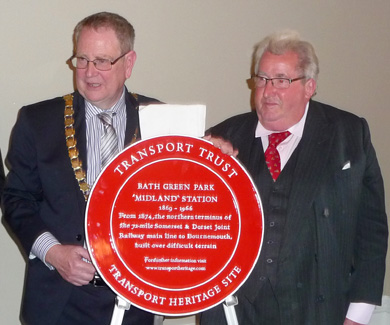 Although The Hon Sir William McAlpine Bt was the guest of honour, he graciously passed the honour of removing the cloth and unveiling the plaque to Cllr Ian Gilchrist, the Chairman of the Council. He did however pose for the commemorative photographs both with Cllr Gilchrist and with other honoured guests.
Although The Hon Sir William McAlpine Bt was the guest of honour, he graciously passed the honour of removing the cloth and unveiling the plaque to Cllr Ian Gilchrist, the Chairman of the Council. He did however pose for the commemorative photographs both with Cllr Gilchrist and with other honoured guests.
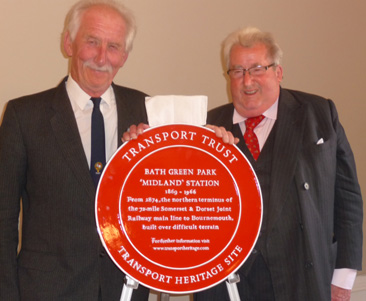 Meanwhile, Watchdog is in favour of the suggestion that the plaque should ideally be on the outside of the station building rather than in the foyer as described in the planning application, and we made this point in our comment on the planning application.
Meanwhile, Watchdog is in favour of the suggestion that the plaque should ideally be on the outside of the station building rather than in the foyer as described in the planning application, and we made this point in our comment on the planning application.
The sample image below shows how it might look beside the front entrance. We have offered our assistance to Cllr Butters to pursue this variation on the permission currently granted.
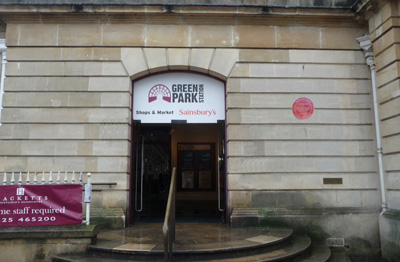
Go back to top index


